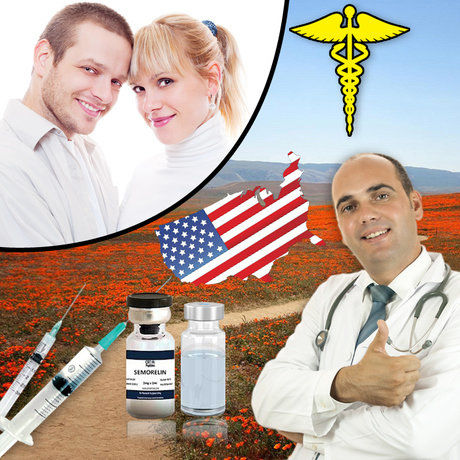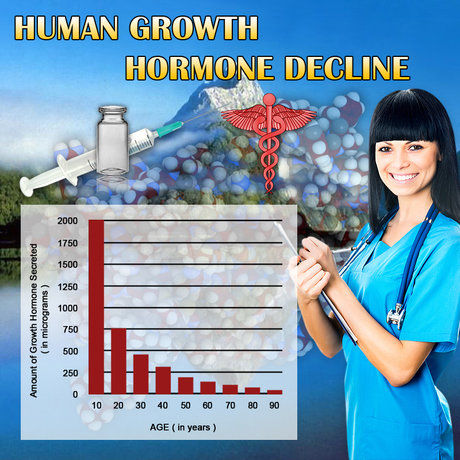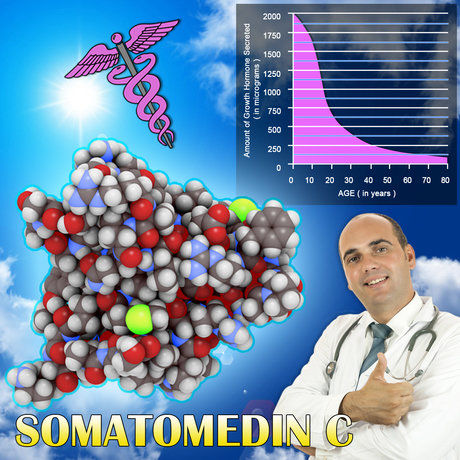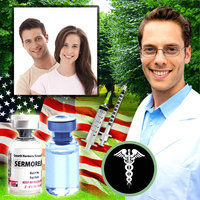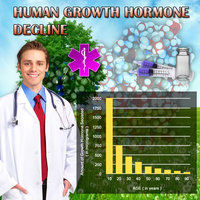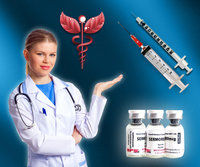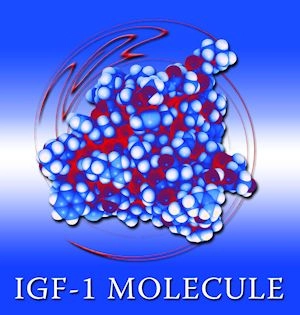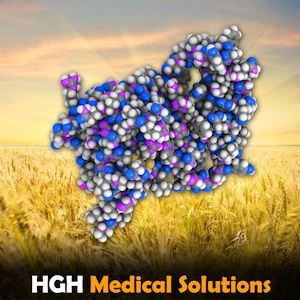 At our clinic, we know that hormone imbalance can be a real drain on your life and feeling of wellness.
At our clinic, we know that hormone imbalance can be a real drain on your life and feeling of wellness.
Chronic fatigue... weight gain… thinning hair...premature aging of skin...anxiety/depression...the list of bad side effects that continuously permeate your life goes on and on.
Things only get worse as you age, especially since human growth hormone and testosterone both tend to decrease significantly as one ages. Thankfully, there are both natural and medical ways to increase your human growth hormone levels, which will be the focus of this article.
The Basics of Human Growth Hormone
We need hormones for our bodies to function correctly. They are involved in so many biochemical processes in our bodies it’s genuinely fantastic to study and understand. Hormones are a part of the endocrine system and are secreted by organs called glands into the bloodstream.
These biochemicals then travel around the body to target organs and tissues, acting as chemical messengers, telling the target tissue what it needs to do, such as telling an ovary to produce and release an egg or for a boy going through puberty to start growing a beard.
Most people have heard about human growth hormone (HGH), usually in relation to performance-enhancing drugs (PEDs) in sports and possibly as an anti-aging strategy used by celebrities such as Suzanne Somers and Sylvester Stallone. Unfortunately, most people are unaware of what HGH is naturally responsible for in the human body.
It is a necessary hormone for both children and adults. Adults need HGH to maintain cellular tissue regeneration and a healthy metabolism, to name the significant roles of the protein hormone.
 In children, HGH is critical for human development in terms of growth and the production and regeneration of cells.
In children, HGH is critical for human development in terms of growth and the production and regeneration of cells.
The protein hormone is produced in the pituitary gland and then released into the bloodstream.
Growth hormone is also produced in the pancreas, intestinal tract, and hypothalamus (which stimulates the pituitary).
HGH is released into the bloodstream in bursts during trauma, sleep, and exercise. More HGH is produced at night, while we sleep, than during the day. When we reach middle age, HGH production significantly starts to decline.
If you have healthy HGH levels, however, you will experience increased protein/muscle production, higher blood sugar levels, and more efficient fat breakdown and utilization.
Healthy Levels of Human Growth Hormone
It is normal for growth hormone levels to fluctuate and change throughout a person’s lifespan, even a healthy person with no hormone imbalance issues. Levels are different between men and women as well.
For men, the typical range of HGH is 0.4 to 10 nanograms/milliliter (ng/mL). For women, the range is 1 to 14 ng/mL. In children, the range is 10 to 50 ng/mL.
Increasing HGH with HRT and Diet, Activity, and Rest
Now that we have a more solid background on human growth hormone and why our bodies need it all through our lives, let's look into how we can boost levels when they are low. As stated previously, we can use both natural and unnatural methods. The first thing to look at is your diet.
Diet
 Not only do the foods that you eat impact your production of HGH, but also how and when you eat.
Not only do the foods that you eat impact your production of HGH, but also how and when you eat.
In addition, any belly fat that you have is directly linked to how much growth hormone you produce.
When someone goes on a growth hormone replacement therapy program, the first place that they see fat loss is in the belly.
Fasting has been shown to have a significant impact on growth hormone production, boosting levels in a way that just a healthy diet cannot do on its own. Following a diet full of protein, healthy fats, and complex carbs can naturally boost your HGH levels without medical therapy. For some, changing up your diet can help; for others, more intervention may be needed. It is best to try the natural methods first.
Physical Activity and Proper Sleep
Engaging in physical activity and following this up with adequate rest and sleep also plays a vital role in the adequate production of HGH. Exercise is one of the most proven ways to naturally increase HGH levels, especially high intensity interval training (HIIT). You can also take a beta-alanine supplement before exercising to increase HGH levels and allow for more weight-lifting repetitions temporarily.
Hormone Replacement Therapy
Another effective way to increase HGH levels is hormone replacement therapy (HRT). This medical intervention involves injecting growth hormone for at least six months or more. How many injections per day or week a patient will need depends on the severity of HGH deficiency.
To get started on HRT, you will need a prescription from an endocrinologist or hormone doctor, such as one from our clinic. Side effects are greatly minimized when a professional oversees growth hormone replacement therapy.
The Benefits of Hormone Replacement Therapy
 Using hormone replacement therapy to increase your HGH levels has its advantages over natural methods.
Using hormone replacement therapy to increase your HGH levels has its advantages over natural methods.
Number one, you’ll be overseen by a professional who will want your blood levels tested consistently to see where they’re at. They will know what to look for and why you might not immediately see the levels you want.
Number two, you don’t have to worry about figuring out the right dosage because the doctor does all of that for you. Number three, perhaps the most important, is that you know you are getting the real thing. If you were to decide to try and get HGH on the black market, good luck getting the genuine, pure thing. Way too risky for anyone to try.
The most common and proven benefits of HGH replacement therapy include the following:
- efficient fat burning
- improved high-intensity exercise performance
- increased muscle mass
- increased bone density
These are the top four benefits of HGH replacement therapy, although patients usually experience more, including better sleep, less anxiety, smoother skin, and healthier hair. If HRT interests you, and you’ve tried improving your diet and exercise regimen, contact our clinic to get started with a comprehensive metabolic/hormone blood panel test.
It just takes one appointment at a clinic to get started. Contact us today! Don’t wait any longer to start feeling healthy and like yourself again!
Contact Us For A Fast And Professional Response

- Sermorelin — HGH Injections Versus Sermorelin and Testosterone Therapy Programs [Last Updated On: February 20th, 2025] [Originally Added On: September 20th, 2020]
- GH-RH Antagonists May be Beneficial in Treating Malignant Melanomas [Last Updated On: April 23rd, 2025] [Originally Added On: October 21st, 2020]
- Sermorelin with GHRP-6 - Hormone Doctor San Diego [Last Updated On: February 18th, 2025] [Originally Added On: October 28th, 2020]
- Get a Quick and Easy Blood Test to Look For Hormone Deficiencies [Last Updated On: May 11th, 2025] [Originally Added On: November 7th, 2020]
- Beneficial Sermorelin Injections for Men and Women: The Next Generation of HGH Restoration [Last Updated On: August 22nd, 2025] [Originally Added On: December 27th, 2020]
- What are the Benefits of Sermorelin Acetate Injections versus HGH Injections? [Last Updated On: April 21st, 2025] [Originally Added On: January 14th, 2021]
- High-Intensity Interval Training to Improve HGH Levels, Hormone Balance, and Health [Last Updated On: August 23rd, 2025] [Originally Added On: January 17th, 2021]
- Sermorelin Therapy 21st Century Injectable Human Growth Hormone Restoration [Last Updated On: May 25th, 2025] [Originally Added On: February 16th, 2021]
- Maximizing Your Sermorelin Acetate Program with Sunshine and Walking [Last Updated On: February 19th, 2025] [Originally Added On: February 18th, 2021]
- Now Is The Time To Learn About The Magic Of Sermorelin Injections [Last Updated On: April 27th, 2025] [Originally Added On: March 2nd, 2021]
- Sermorelin vs. Human Growth Hormone Therapy [Last Updated On: March 15th, 2025] [Originally Added On: April 26th, 2021]
- Does Sermorelin Work? [Last Updated On: May 27th, 2025] [Originally Added On: May 4th, 2021]
- Buy Sermorelin -- What to do When Sermorelin Arrives in the Postal Mail [Last Updated On: February 16th, 2025] [Originally Added On: May 9th, 2021]
- HGH Secretagogues, Sermorelin Injections and Growth Hormone Releasing Hormone (Hypothalamus) - Video [Last Updated On: February 18th, 2025] [Originally Added On: May 11th, 2021]
- Age Management with Sermorelin Injection Treatment [Last Updated On: March 7th, 2025] [Originally Added On: May 23rd, 2021]
- Stem Cells Found For The First Time In The Pituitary [Last Updated On: May 14th, 2025] [Originally Added On: May 24th, 2021]
- Omnitrope is a Great Option for Men or Women with HGH Deficiency [Last Updated On: October 22nd, 2025] [Originally Added On: June 14th, 2021]
- HGH Injections on the Run [Last Updated On: February 4th, 2025] [Originally Added On: May 10th, 2023]
- All You Need to Know About HRT & Osteoporosis [Last Updated On: September 13th, 2025] [Originally Added On: June 16th, 2023]
- Unlocking the Elixir of Youth: Revealing the Untold Potential of Sermorelin [Last Updated On: February 25th, 2025] [Originally Added On: February 25th, 2025]
- Regaining Youthfulness: Sermorelin’s Role in Revitalizing Your Body’s Growth Hormone [Last Updated On: February 26th, 2025] [Originally Added On: February 26th, 2025]
- Unlocking the Secret to Youthfulness: Unraveling the Impact of Sermorelin in Anti-Aging Therapy [Last Updated On: February 27th, 2025] [Originally Added On: February 27th, 2025]
- Transforming Medical Science: Sermorelin's Ascendancy In The Modern World [Last Updated On: February 28th, 2025] [Originally Added On: February 28th, 2025]
- Revitalizing Elixir of Life: An Exploration into the Efficacious Role of Sermorelin in Reigniting the Body's Innate Growth Hormone [Last Updated On: February 28th, 2025] [Originally Added On: February 28th, 2025]
- Unveiling the Future of Therapeutics: A Comprehensive Examination of Sermorelin Benefits [Last Updated On: March 1st, 2025] [Originally Added On: March 1st, 2025]
- Exploring Chronological Rejuvenation: The Role of Sermorelin in Anti-Aging Medicine [Last Updated On: March 2nd, 2025] [Originally Added On: March 2nd, 2025]
- Exploring Sermorelin: A Natural Alternative to Synthetic Growth Hormone Therapy for Enhanced Vitality and Reduced Side Effects [Last Updated On: March 3rd, 2025] [Originally Added On: March 3rd, 2025]
- Exploring Sermorelin's Role in Enhancing Vitality Among American Men [Last Updated On: March 4th, 2025] [Originally Added On: March 4th, 2025]
- Exploring Sermorelin Therapy for Aging: Benefits for American Males [Last Updated On: March 5th, 2025] [Originally Added On: March 5th, 2025]
- Exploring Sermorelin Therapy for Hormonal Imbalance in Aging Men [Last Updated On: March 6th, 2025] [Originally Added On: March 6th, 2025]
- Unlocking Sermorelin: The Natural Path to Enhanced Growth Hormone Levels in Men [Last Updated On: March 7th, 2025] [Originally Added On: March 7th, 2025]
- Unlocking the Anti-Aging Potential of Sermorelin: Benefits for Aging American Males [Last Updated On: March 8th, 2025] [Originally Added On: March 8th, 2025]
- The Regenerative Power of Sermorelin for Male Tissue Regeneration and Healthy Aging [Last Updated On: March 9th, 2025] [Originally Added On: March 9th, 2025]
- Sermorelin Therapy: Enhancing Growth Hormone for American Males' Health and Vitality [Last Updated On: March 9th, 2025] [Originally Added On: March 9th, 2025]
- Unveiling the Multifaceted Health Benefits of Sermorelin for American Men [Last Updated On: March 11th, 2025] [Originally Added On: March 11th, 2025]
- Exploring the Biochemical Wonders of Sermorelin: A Deep Dive for American Males [Last Updated On: March 12th, 2025] [Originally Added On: March 12th, 2025]
- Unlocking Vitality: The Role of Sermorelin in Boosting Natural HGH Levels in American Men [Last Updated On: March 13th, 2025] [Originally Added On: March 13th, 2025]
- Unleashing Vitality: The Transformative Power of Sermorelin in American Males [Last Updated On: March 15th, 2025] [Originally Added On: March 15th, 2025]
- Exploring the Therapeutic Potential of Sermorelin in Accelerating Recovery for American Males [Last Updated On: March 15th, 2025] [Originally Added On: March 15th, 2025]
- Sermorelin: Enhancing Growth and Vitality in American Males Through Peptide Therapy [Last Updated On: March 16th, 2025] [Originally Added On: March 16th, 2025]
- Sermorelin: Enhancing Health and Vitality in American Males Through Regenerative Medicine [Last Updated On: March 17th, 2025] [Originally Added On: March 17th, 2025]
- Sermorelin: Enhancing Longevity and Quality of Life in American Males [Last Updated On: March 17th, 2025] [Originally Added On: March 17th, 2025]
- Sermorelin: Enhancing Vitality and Health in American Males Through Hormonal Optimization [Last Updated On: March 18th, 2025] [Originally Added On: March 18th, 2025]
- Sermorelin: Enhancing Vitality and Health in American Males Through Regenerative Medicine [Last Updated On: March 18th, 2025] [Originally Added On: March 18th, 2025]
- Sermorelin Therapy: Personalized Approach to Enhancing Male Health and Vitality [Last Updated On: March 18th, 2025] [Originally Added On: March 18th, 2025]
- Sermorelin: Enhancing Vitality and Health in Aging American Men [Last Updated On: March 18th, 2025] [Originally Added On: March 18th, 2025]
- Maximizing Sermorelin Benefits: Diet, Exercise, Sleep, and Stress Management for American Males [Last Updated On: March 21st, 2025] [Originally Added On: March 21st, 2025]
- Sermorelin: Enhancing Health and Vitality in American Males Through Regenerative Medicine [Last Updated On: March 21st, 2025] [Originally Added On: March 21st, 2025]
- Sermorelin: Enhancing Vitality and Cellular Health in American Males [Last Updated On: March 21st, 2025] [Originally Added On: March 21st, 2025]
- Sermorelin: Enhancing Body Composition in American Males Safely and Effectively [Last Updated On: March 22nd, 2025] [Originally Added On: March 22nd, 2025]
- Sermorelin: Enhancing Vitality and Health in Aging American Males [Last Updated On: March 22nd, 2025] [Originally Added On: March 22nd, 2025]
- Sermorelin: Enhancing Vitality and Body Composition in American Males - Evidence and Risks [Last Updated On: March 22nd, 2025] [Originally Added On: March 22nd, 2025]
- Sermorelin vs. HGH Therapy: Benefits and Risks for American Males' Health [Last Updated On: March 22nd, 2025] [Originally Added On: March 22nd, 2025]
- Sermorelin: Enhancing Tissue Regeneration in American Males [Last Updated On: March 22nd, 2025] [Originally Added On: March 22nd, 2025]
- Sermorelin: Enhancing HGH for American Males' Health and Vitality [Last Updated On: March 23rd, 2025] [Originally Added On: March 23rd, 2025]
- Sermorelin: Enhancing Growth Hormone for American Males Across All Ages [Last Updated On: March 23rd, 2025] [Originally Added On: March 23rd, 2025]
- Sermorelin Benefits for American Men: Sleep, Stress, Growth, and Vitality Enhancement [Last Updated On: March 24th, 2025] [Originally Added On: March 24th, 2025]
- Sermorelin: Enhancing Energy, Mood, and Metabolism in American Males [Last Updated On: March 24th, 2025] [Originally Added On: March 24th, 2025]
- Sermorelin: A Natural Anti-Aging Solution for American Males [Last Updated On: March 24th, 2025] [Originally Added On: March 24th, 2025]
- Sermorelin: Enhancing Muscle Repair and Performance in American Males [Last Updated On: March 24th, 2025] [Originally Added On: March 24th, 2025]
- Sermorelin: Enhancing Regeneration in American Males for Health and Vitality [Last Updated On: March 24th, 2025] [Originally Added On: March 24th, 2025]
- Sermorelin: Enhancing Vitality and Graceful Aging in American Men [Last Updated On: March 24th, 2025] [Originally Added On: March 24th, 2025]
- Sermorelin: Enhancing Vitality and Health in American Males Through GH Stimulation [Last Updated On: March 24th, 2025] [Originally Added On: March 24th, 2025]
- Sermorelin: Enhancing Post-Surgical Recovery for American Males [Last Updated On: March 25th, 2025] [Originally Added On: March 25th, 2025]
- Sermorelin: Enhancing Men's Hormonal Health Holistically [Last Updated On: March 25th, 2025] [Originally Added On: March 25th, 2025]
- Sermorelin's Molecular Mechanisms and Health Benefits for American Males [Last Updated On: March 25th, 2025] [Originally Added On: March 25th, 2025]
- Sermorelin: Boosting Energy and Fat Loss in American Males [Last Updated On: March 25th, 2025] [Originally Added On: March 25th, 2025]
- Sermorelin Therapy Benefits for American Males: Muscle, Bone, Cognitive, and Metabolic Health [Last Updated On: March 25th, 2025] [Originally Added On: March 25th, 2025]
- Sermorelin: Enhancing Performance and Health in American Males [Last Updated On: March 25th, 2025] [Originally Added On: March 25th, 2025]
- Sermorelin: Transforming Chronic Fatigue into Fitness for American Men [Last Updated On: March 25th, 2025] [Originally Added On: March 25th, 2025]
- Sermorelin: Boosting Metabolism and Vitality in American Males [Last Updated On: March 26th, 2025] [Originally Added On: March 26th, 2025]
- Sermorelin: Enhancing Skin, Hair, and Vitality in American Men [Last Updated On: March 26th, 2025] [Originally Added On: March 26th, 2025]
- Sermorelin: Enhancing Vitality and Health in Aging American Men [Last Updated On: March 26th, 2025] [Originally Added On: March 26th, 2025]
- Sermorelin: Enhancing GH Production and Health in American Males [Last Updated On: March 26th, 2025] [Originally Added On: March 26th, 2025]
- Sermorelin: Enhancing Hormonal Health and Vitality in American Men [Last Updated On: March 26th, 2025] [Originally Added On: March 26th, 2025]
- Sermorelin: Enhancing Vitality and Health in American Males Through GH Stimulation [Last Updated On: March 27th, 2025] [Originally Added On: March 27th, 2025]
- Sermorelin: Revolutionizing Anti-Aging for American Males with GH Enhancement [Last Updated On: March 27th, 2025] [Originally Added On: March 27th, 2025]
- Sermorelin Therapy: A Promising HRT Option for Aging American Males [Last Updated On: March 27th, 2025] [Originally Added On: March 27th, 2025]
- Sermorelin: Enhancing Recovery and Performance in American Male Athletes [Last Updated On: March 27th, 2025] [Originally Added On: March 27th, 2025]
- Sermorelin Therapy Enhanced by Diet and Exercise for American Males' Health [Last Updated On: March 27th, 2025] [Originally Added On: March 27th, 2025]
